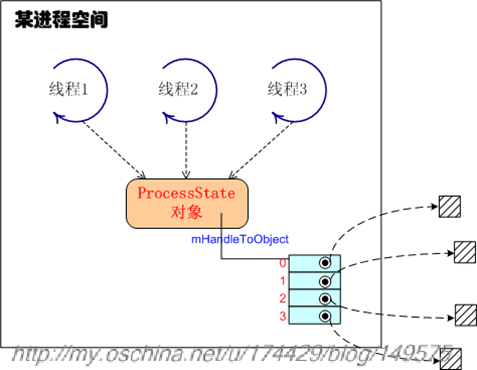[Android進階]Binder學習(初始篇)
Android中Binder學習(初始篇)
本篇部落格學習自侯亮的部落格,地址為:
1 什麼是Binder?
簡單地說,Binder是Android平臺上的一種跨程序互動技術。該技術最早並不是由Google公司提出的,它的前身是Be Inc公司開發的OpenBinder,而且在Palm中也有應用。後來OpenBinder的作者Dianne Hackborn加入了Google公司,並負責Android平臺的開發工作,所以把這項技術也帶進了Android。
我們知道,在Android的應用層次上,基本上已經沒有過去的程序概念了。然而在實現層次,它畢竟還是要建構在一個個程序之上的。實際上,在Android內部,那些支撐應用的元件往往會身處於不同的程序,那麼應用的底層必然會牽涉大量的跨程序通訊。為了保證通訊的高效性,Android提供了Binder機制。
Binder機制具有兩層含義:
- 是一種跨程序通訊手段(IPC, Inter-Process Communication)。
- 是一種遠端過程呼叫手段(RPC,Remote Procedure Call)。
從實現的角度來說,Binder核心被實現成一個Linux驅動程式,並運行於核心態。這樣它才能具有強大的跨程序訪問能力。
1.1 簡述Binder的跨程序機制
為了理解Binder,我們可以先畫一張最簡單的跨程序通訊示意圖:
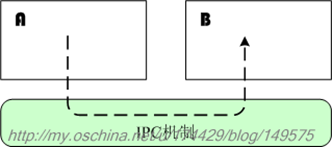
這個很容易理解,不需贅言。到了Android平臺上,IPC機制就變成了Binder機制,情況類似,只不過為了便於說明問題,我們需要稍微調整一下示意圖:
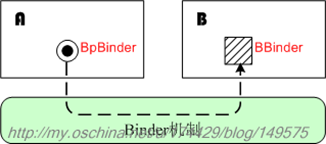
圖中A側的圓形塊,表示“Binder代理方”,主要用於向遠方傳送語義,而B側的方形塊則表示“Binder響應方”,主要用於響應語義。需要說明的是,這種圖形表示方法是我自己杜撰的,並沒有正規的出處。我個人覺得這種圖形非常簡便,所以在分析Android架構時,會經常使用這種表示法。
在後文中,我們可以看到,Binder代理方大概對應於C++層次的BpBinder物件,而Binder響應方則對應於BBinder物件。這兩個物件在後文會詳細闡述,此處不必太細究。
然而,上圖的Binder代理方主要只負責了“傳遞資訊”的工作,並沒有起到“遠端過程呼叫”的作用,如果要支援遠端過程呼叫,我們還必須提供“介面代理方”和“介面實現體”。這樣,我們的示意圖就需要再調整一下,如下:

從圖中可以看到,A程序並不直接和BpBinder(Binder代理)打交道,而是通過呼叫BpInterface(介面代理)的成員函式來完成遠端呼叫的。此時,BpBinder已經被聚合進BpInterface了,它在BpInterface內部完成了一切跨程序的機制。另一方面,與BpInterface相對的響應端實體就是BnInterface(介面實現)了。需要注意的是,BnInterface是繼承於BBinder的,它並沒有採用聚合的方式來包含一個BBinder物件,所以上圖中B側的BnInterface塊和BBinder塊的背景圖案是相同的。
這樣看來,對於遠端呼叫的客戶端而言,主要搞的就是兩個東西,一個是“Binder代理”,一個是“介面代理”。而服務端主要搞的則是“介面實現體”。因為binder是一種跨程序通訊機制,所以還需要一個專門的管理器來為通訊兩端牽線搭橋,這個管理器就是Service Manager Service。不過目前我們可以先放下Service Manager Service,以後再詳細研究。
2 Binder相關介面和類
Android的整個跨程序通訊機制都是基於Binder的,這種機制不但會在底層使用,也會在上層使用,所以必須提供Java和C++兩個層次的支援。
2.1 Java層次的binder元素
Java層次裡並沒有我們前文圖中所表示的BpBinder、BpInterface、BBinder等較低層次的概念,取而代之的是IBinder介面、IInterface等介面。Android要求所有的Binder實體都必須實現IBinder介面,該介面的定義截選如下:
【frameworks/base/core/java/android/os/IBinder.java】
public interface IBinder
{
. . . . . .
public String getInterfaceDescriptor() throws RemoteException;
public boolean pingBinder();
public boolean isBinderAlive();
public IInterface queryLocalInterface(String descriptor);
public void dump(FileDescriptor fd, String[] args) throws RemoteException;
public void dumpAsync(FileDescriptor fd, String[] args) throws RemoteException;
public boolean transact(int code, Parcel data, Parcel reply, int flags)
throws RemoteException;
public interface DeathRecipient
{
public void binderDied();
}
public void linkToDeath(DeathRecipient recipient, int flags)throws RemoteException;
public boolean unlinkToDeath(DeathRecipient recipient, int flags);
}
另外,不管是代理方還是實體方,都必須實現IInterface介面:
public interface IInterface
{
public IBinder asBinder();
}Java層次中,與Binder相關的介面或類的繼承關係如下:
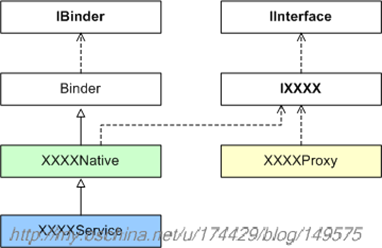
在實際使用中,我們並不需要編寫上圖的XXXXNative、XXXXProxy,它們會由ADT根據我們編寫的aidl指令碼自動生成。使用者只需繼承XXXXNative編寫一個具體的XXXXService即可,這個XXXXService就是遠端通訊的服務實體類,而XXXXProxy則是其對應的代理類。
關於Java層次的binder元件,我們就先說這麼多,主要是先介紹一個大概。就研究跨程序通訊而言,其實質內容基本上都在C++層次,Java層次只是一個殼而已。以後我會寫專文來打通Java層次和C++層次,看看它們是如何通過JNI技術關聯起來的。現在我們還是把注意力集中在C++層次吧。
2.2 C++層次的binder元素
在C++層次,就能看到我們前文所說的BpBinder類和BBinder類了。這兩個類都繼承於IBinder,IBinder的定義截選如下:
【frameworks/native/include/binder/IBinder.h】
class IBinder : public virtual RefBase
{
public:
. . . . . .
IBinder();
virtual sp<IInterface> queryLocalInterface(const String16& descriptor);
virtual const String16& getInterfaceDescriptor() const = 0;
virtual bool isBinderAlive() const = 0;
virtual status_t pingBinder() = 0;
virtual status_t dump(int fd, const Vector<String16>& args) = 0;
virtual status_t transact(uint32_t code, const Parcel& data,
Parcel* reply, uint32_t flags = 0) = 0;
class DeathRecipient : public virtual RefBase
{
public:
virtual void binderDied(const wp<IBinder>& who) = 0;
};
virtual status_t linkToDeath(const sp<DeathRecipient>& recipient,
void* cookie = NULL, uint32_t flags = 0) = 0;
virtual status_t unlinkToDeath(const wp<DeathRecipient>& recipient,
void* cookie = NULL, uint32_t flags = 0,
wp<DeathRecipient>* outRecipient = NULL) = 0;
virtual bool checkSubclass(const void* subclassID) const;
typedef void (*object_cleanup_func)(const void* id, void* obj, void* cleanupCookie);
virtual void attachObject(const void* objectID, void* object,
void* cleanupCookie, object_cleanup_func func) = 0;
virtual void* findObject(const void* objectID) const = 0;
virtual void detachObject(const void* objectID) = 0;
virtual BBinder* localBinder();
virtual BpBinder* remoteBinder();
protected:
virtual ~IBinder();
private:
};C++層次的繼承關係圖如下:

其中有以下幾個很關鍵的類:
- BpBinder
- BpInterface
- BBinder
- BnInterface
它們扮演著很重要的角色。
2.2.1 BpBinder
BpBinder的定義截選如下:
class BpBinder : public IBinder
{
public:
BpBinder(int32_t handle);
inline int32_t handle() const { return mHandle; }
virtual const String16& getInterfaceDescriptor() const;
virtual bool isBinderAlive() const;
virtual status_t pingBinder();
virtual status_t dump(int fd, const Vector<String16>& args);
virtual status_t transact(uint32_t code, const Parcel& data,
Parcel* reply, uint32_t flags = 0);
virtual status_t linkToDeath(const sp<DeathRecipient>& recipient,
void* cookie = NULL, uint32_t flags = 0);
virtual status_t unlinkToDeath(const wp<DeathRecipient>& recipient,
void* cookie = NULL, uint32_t flags = 0,
wp<DeathRecipient>* outRecipient = NULL);
. . . . . .
. . . . . .作為代理端的核心,BpBinder最重要的職責就是實現跨程序傳輸的傳輸機制,至於具體傳輸的是什麼語義,它並不關心。我們觀察它的transact()函式的引數,可以看到所有的語義都被打包成Parcel了。其他的成員函式,我們先不深究,待我們儲備了足夠的基礎知識後,再回過頭研究它們不遲。
2.2.2 BpInterface
另一個重要的類是BpInterface,它的定義如下:
template<typename INTERFACE>
class BpInterface : public INTERFACE, public BpRefBase
{
public:
BpInterface(const sp<IBinder>& remote);
protected:
virtual IBinder* onAsBinder();
};其基類BpRefBase的定義如下:
class BpRefBase : public virtual RefBase
{
protected:
BpRefBase(const sp<IBinder>& o);
virtual ~BpRefBase();
virtual void onFirstRef();
virtual void onLastStrongRef(const void* id);
virtual bool onIncStrongAttempted(uint32_t flags, const void* id);
inline IBinder* remote() { return mRemote; }
inline IBinder* remote() const { return mRemote; }
private:
BpRefBase(const BpRefBase& o);
BpRefBase& operator=(const BpRefBase& o);
IBinder* const mRemote;
RefBase::weakref_type* mRefs;
volatile int32_t mState;
};BpInterface使用了模板技術,而且因為它繼承了BpRefBase,所以先天上就聚合了一個mRemote成員,這個成員記錄的就是前面所說的BpBinder物件啦。以後,我們還需要繼承BpInterface<>實現我們自己的代理類。
在實際的程式碼中,我們完全可以建立多個聚合同一BpBinder物件的代理物件,這些代理物件就本質而言,對應著同一個遠端binder實體。在Android框架中,常常把指向同一binder實體的多個代理稱為token,這樣即便這些代理分別處於不同的程序中,它們也具有了某種內在聯絡。這個知識點需要大家關注。
2.2.3 BBinder
Binder遠端通訊的目標端實體必須繼承於BBinder類,該類和BpBinder相對,主要關心的只是傳輸方面的東西,不太關心所傳輸的語義。
class BBinder : public IBinder
{
public:
BBinder();
virtual const String16& getInterfaceDescriptor() const;
virtual bool isBinderAlive() const;
virtual status_t pingBinder();
virtual status_t dump(int fd, const Vector<String16>& args);
virtual status_t transact(uint32_t code, const Parcel& data,
Parcel* reply, uint32_t flags = 0);
virtual status_t linkToDeath(const sp<DeathRecipient>& recipient,
void* cookie = NULL, uint32_t flags = 0);
virtual status_t unlinkToDeath(const wp<DeathRecipient>& recipient,
void* cookie = NULL, uint32_t flags = 0,
wp<DeathRecipient>* outRecipient = NULL);
virtual void attachObject(const void* objectID, void* object,
void* cleanupCookie, object_cleanup_func func);
virtual void* findObject(const void* objectID) const;
virtual void detachObject(const void* objectID);
virtual BBinder* localBinder();
protected:
virtual ~BBinder();
virtual status_t onTransact(uint32_t code, const Parcel& data,
Parcel* reply, uint32_t flags = 0);
private:
BBinder(const BBinder& o);
BBinder& operator=(const BBinder& o);
class Extras;
Extras* mExtras;
void* mReserved0;
};我們目前只需關心上面的transact()成員函式,其他函式留待以後再分析。transact函式的程式碼如下:
【frameworks/native/libs/binder/Binder.cpp】
status_t BBinder::transact(uint32_t code, const Parcel& data,
Parcel* reply, uint32_t flags)
{
data.setDataPosition(0);
status_t err = NO_ERROR;
switch (code)
{
case PING_TRANSACTION:
reply->writeInt32(pingBinder());
break;
default:
err = onTransact(code, data, reply, flags);
break;
}
if (reply != NULL)
{
reply->setDataPosition(0);
}
return err;
}看到了嗎,transact()內部會呼叫onTransact(),從而走到使用者所定義的子類的onTransact()裡。這個onTransact()的一大作用就是解析經由Binder機制傳過來的語義了。
2.2.4 BnInterface
遠端通訊目標端的另一個重要類是BnInterface<>,它是與BpInterface<>相對應的模板類,比較關心傳輸的語義。一般情況下,服務端並不直接使用BnInterface<>,而是使用它的某個子類。為此,我們需要編寫一個新的BnXXX子類,並重載它的onTransact()成員函式。
BnInterface<>的定義如下:
template<typename INTERFACE>
class BnInterface : public INTERFACE, public BBinder
{
public:
virtual sp<IInterface> queryLocalInterface(const String16& _descriptor);
virtual const String16& getInterfaceDescriptor() const;
protected:
virtual IBinder* onAsBinder();
};如上所示,BnInterface<>繼承於BBinder,但它並沒有實現一個預設的onTransact()成員函式,所以在遠端通訊時,前文所說的BBinder::transact()呼叫的onTransact()應該就是BnInterface<>的某個子類的onTransact()成員函式。
2.3 幾個重要的C++巨集或模板
為了便於編寫新的介面和類,Android在C++層次提供了幾個重要的巨集和模板,比如我們在IInterface.h檔案中,可以看到DECLARE_META_INTERFACE、IMPLEMENT_META_INTERFACE的定義。
2.3.1 DECLARE_META_INTERFACE()
DECLARE_META_INTERFACE()的定義如下:
#define DECLARE_META_INTERFACE(INTERFACE) \
static const android::String16 descriptor; \
static android::sp<I##INTERFACE> asInterface( \
const android::sp<android::IBinder>& obj); \
virtual const android::String16& getInterfaceDescriptor() const; \
I##INTERFACE(); \
virtual ~I##INTERFACE(); \我們舉個實際的例子,來說明如何使用這個巨集:

上例中ICamera內部使用了DECLARE_META_INTERFACE(Camera),我們把巨集展開後,可以看到ICamera類的定義相當於:
class ICamera: public IInterface
{
public:
static const android::String16 descriptor;
static android::sp<ICamera> asInterface( const android::sp<android::IBinder>& obj);
virtual const android::String16& getInterfaceDescriptor() const;
ICamera();
virtual ~ICamera();
virtual void disconnect() = 0;
. . . . . .巨集展開的部分就是中間那5行程式碼,其中最關鍵的就是asInterface()函數了,這個函式將承擔把BpBinder打包成BpInterface的職責。
2.3.2 IMPLEMENT_META_INTERFACE()
與DECLARE_META_INTERFACE相對的就是IMPLEMENT_META_INTERFACE巨集。它的定義如下:
#define IMPLEMENT_META_INTERFACE(INTERFACE, NAME) \
const android::String16 I##INTERFACE::descriptor(NAME); \
const android::String16& \
I##INTERFACE::getInterfaceDescriptor() const { \
return I##INTERFACE::descriptor; \
} \
android::sp<I##INTERFACE> I##INTERFACE::asInterface( \
const android::sp<android::IBinder>& obj) \
{ \
android::sp<I##INTERFACE> intr; \
if (obj != NULL) { \
intr = static_cast<I##INTERFACE*>( \
obj->queryLocalInterface( \
I##INTERFACE::descriptor).get()); \
if (intr == NULL) { \
intr = new Bp##INTERFACE(obj); \
} \
} \
return intr; \
} \
I##INTERFACE::I##INTERFACE() { } \
I##INTERFACE::~I##INTERFACE() { } \其中,實現了關鍵的asInterface()函式。
實際使用IMPLEMENT_META_INTERFACE時,我們只需把它簡單地寫在binder實體所處的cpp檔案中即可,舉例如下:
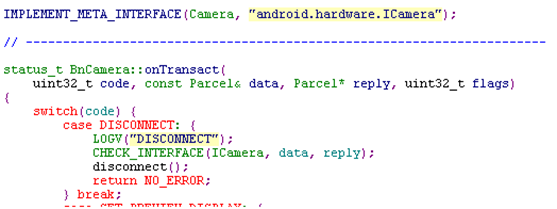
其中的IMPLEMENT_META_INTERFACE(Camera, “android.hardware.ICamera”);一句相當於以下這段程式碼:
const android::String16 ICamera::descriptor(“android.hardware.ICamera”);
const android::String16& ICamera::getInterfaceDescriptor() const
{
return ICamera::descriptor;
}
android::sp<ICamera> ICamera::asInterface(const android::sp<android::IBinder>& obj)
{
android::sp<ICamera > intr;
if (obj != NULL)
{
intr = static_cast<ICamera*>(obj->queryLocalInterface(
ICamera::descriptor).get());
if (intr == NULL)
{
intr = new BpCamera(obj);
}
}
return intr;
}
ICamera::ICamera() { }
ICamera::~ICamera () { } 看來,其中重點實現了asInterface()成員函式。請注意,asInterface()函式中會先嚐試呼叫queryLocalInterface()來獲取intr。此時,如果asInterface()的obj引數是個代理物件(BpBinder),那麼intr = static_cast
sp<IInterface> IBinder::queryLocalInterface(const String16& descriptor)
{
return NULL;
}另一方面,如果obj引數是個實現體物件(BnInterface物件)的話,那麼queryLocalInterface()函式的預設返回值就是實體物件的this指標了,程式碼如下:
【frameworks/native/include/binder/IInterface.h】
template<typename INTERFACE>
inline sp<IInterface> BnInterface<INTERFACE>::queryLocalInterface(const String16& _descriptor)
{
if (_descriptor == INTERFACE::descriptor)
return this;
return NULL;
}在我們所舉的Camera例子中,我們要研究的是如何將BpBinder轉成BpInterface,所以現在我們只闡述obj引數為BpBinder的情況。此時asInterface()函式中obj->queryLocalInterface()的返回值為NULL,於是asInterface()會走到new BpCamera(obj)一句,這一句是最關鍵的一句。我們知道,BpCamera繼承於BpInterface,所以此時所建立的BpCamera物件正是可被App使用的BpInterface代理物件。
BpCamera的定義如下:
class BpCamera: public BpInterface<ICamera>
{
public:
BpCamera(const sp<IBinder>& impl)
: BpInterface<ICamera>(impl)
{
}
// disconnect from camera service
void disconnect()
{
LOGV("disconnect");
Parcel data, reply;
data.writeInterfaceToken(ICamera::getInterfaceDescriptor());
remote()->transact(DISCONNECT, data, &reply);
}
. . . . . .至此,IMPLEMENT_META_INTERFACE巨集和asInterface()函式的關係就分析完畢了。
2.3.3 interface_cast
不過,我們經常使用的其實並不是asInterface()函式,而是interface_cast(),它簡單包裝了asInterface():
template<typename INTERFACE>
inline sp<INTERFACE> interface_cast(const sp<IBinder>& obj)
{
return INTERFACE::asInterface(obj);
}以上就是關於C++層次中一些binder元素的介紹,下面我們再進一步分析其他細節。
3 ProcessState
前文我們已經提到過,在Android的上層架構中,已經大幅度地弱化了程序的概念。應用程式設計師能看到的主要是activity、service、content provider等概念,再也找不到以前熟悉的main()函數了。然而,底層程式(C++層次)畢竟還是得跑在一個個程序之上,現在我們就來看底層程序是如何運用Binder機制來完成跨程序通訊的。
在每個程序中,會有一個全域性的ProcessState物件。這個很容易理解,ProcessState的字面意思不就是“程序狀態”嗎,當然應該是每個程序一個ProcessState。ProcessState的定義位於frameworks/native/include/binder/ProcessState.h中,我們只截選其中的一部分:
class ProcessState : public virtual RefBase
{
public:
static sp<ProcessState> self();
. . . . . .
void startThreadPool();
. . . . . .
void spawnPooledThread(bool isMain);
status_t setThreadPoolMaxThreadCount(size_t maxThreads);
private:
friend class IPCThreadState;
. . . . . .
struct handle_entry
{
IBinder* binder;
RefBase::weakref_type* refs;
};
handle_entry* lookupHandleLocked(int32_t handle);
int mDriverFD;
void* mVMStart;
mutable Mutex mLock; // protects everything below.
Vector<handle_entry> mHandleToObject;
. . . . . .
KeyedVector<String16, sp<IBinder> > mContexts;
. . . . . .
};我們知道,Binder核心被設計成一個驅動程式,所以ProcessState裡專門搞了個mDriverFD域,來記錄binder驅動對應的控制代碼值,以便隨時和binder驅動通訊。ProcessState物件採用了典型的單例模式,在一個應用程序中,只會有唯一的一個ProcessState物件,它將被程序中的多個執行緒共用,因此每個程序裡的執行緒其實是共用所開啟的那個驅動控制代碼(mDriverFD)的,示意圖如下:

每個程序基本上都是這樣的結構,組合起來的示意圖就是:
我們常見的使用ProcessState的程式碼如下:
int main(int argc, char** argv)
{
sp<ProcessState> proc(ProcessState::self());
. . . . . .
. . . . . .
ProcessState::self()->startThreadPool();
IPCThreadState::self()->joinThreadPool();
}因為ProcessState採用的是單例模式,所以它的建構函式是private的,我們只能通過呼叫ProcessState::self()來獲取程序中唯一的一個ProcessState物件。self()函式的程式碼如下:
sp<ProcessState> ProcessState::self()
{
Mutex::Autolock _l(gProcessMutex);
if (gProcess != NULL) {
return gProcess;
}
gProcess = new ProcessState;
return gProcess;
}ProcessState物件構造之時,就會開啟binder驅動:
ProcessState::ProcessState()
: mDriverFD(open_driver()) // 開啟binder驅動。
, mVMStart(MAP_FAILED)
, mManagesContexts(false)
, mBinderContextCheckFunc(NULL)
, mBinderContextUserData(NULL)
, mThreadPoolStarted(false)
, mThreadPoolSeq(1)
{
. . . . . .
mVMStart = mmap(0, BINDER_VM_SIZE, PROT_READ, MAP_PRIVATE | MAP_NORESERVE, mDriverFD, 0);
. . . . . .
}注意上面那句mDriverFD(open_driver()),其中的open_driver()就負責開啟“/dev/binder”驅動:
static int open_driver()
{
int fd = open("/dev/binder", O_RDWR);
. . . . . .
status_t result = ioctl(fd, BINDER_VERSION, &vers);
. . . . . .
size_t maxThreads = 15;
result = ioctl(fd, BINDER_SET_MAX_THREADS, &maxThreads);
. . . . . .
return fd;
}ProcessState中另一個比較有意思的域是mHandleToObject:
Vector<handle_entry> mHandleToObject;它是本程序中記錄所有BpBinder的向量表噢,非常重要。我們前文已經說過,BpBinder是代理端的核心,現在終於看到它的藏身之處了。在Binder架構中,應用程序是通過“binder控制代碼”來找到對應的BpBinder的。從這張向量表中我們可以看到,那個控制代碼值其實對應著這個向量表的下標。這張表的子項型別為handle_entry,定義如下:
struct handle_entry
{
IBinder* binder;
RefBase::weakref_type* refs;
};其中的binder域,記錄的就是BpBinder物件。
